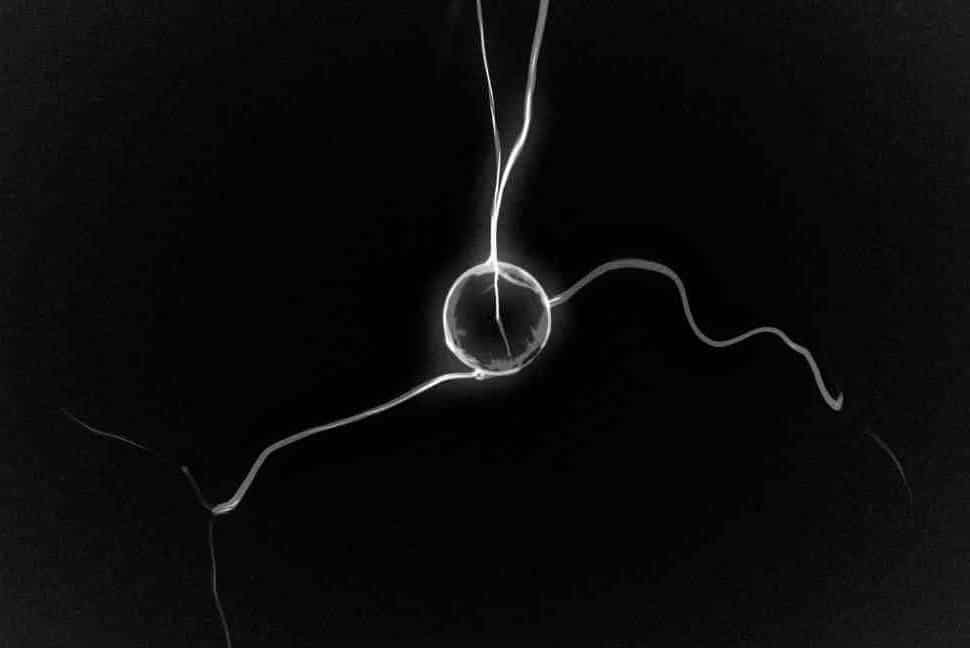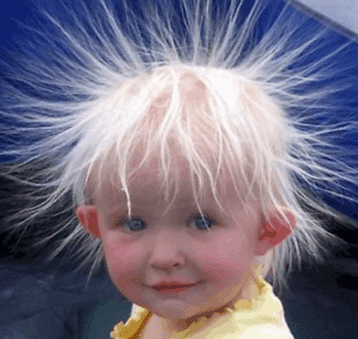Electric current (current electric) refers to the rate of flow of negative charges in a conductor.
In simple words, an electric current is the continuous movement of electrons in an electric circuit. The conducting substance (mostly metal) is made up of a vast number of free electrons that travel randomly from one atom to the next.

Table of Contents
Unit of Electric Current
The SI unit of current is the ampere, which quantifies the rate at which electric charge flows over a surface at one coulomb per second. Since the charge is measured in coulombs and time is measured in seconds, the unit is coulomb/second (C/s) or amp. Likewise, the electric current formula is as follows:
I = V/R
Where,
- I = Electric Current
- V = Voltage
- R = Resistance of the material
Ampere Definition
When charge flows through a wire at a rate of one coulomb per second, it is said to carry a current of one ampere.
How Current Flows?
When an electrical potential difference is introduced across the metallic wire, the loosely attached free electrons begin to move towards the cell’s positive terminal. The electrical current is made up of this constant flow of electrons. Current flows in the wire from the cell’s negative terminal to the positive terminal via the external circuit.
Conventional Direction of Flow of Current
The conventional flow of current through the external circuit is from the positive terminal of the cell to the negative terminal of the cell. The rate of flow of electrons, or charge flowing per second, determines the magnitude of current flow in any segment of the conductor.
Types of Electric Current
The current is classified into two types based on the passage of electric charge: alternating current and direct current. Charges flow unidirectionally in direct current, but charges flow in both directions in alternating current.
Alternating Current
When an electric charge reverses direction on a regular basis, it is known as alternating current (AC).
The direction of the current in the United States reverses/alters at 60 Hertz (cycles per second). The sine wave is the most prevalent waveform in AC, however alternative waveforms include square and triangle waves.
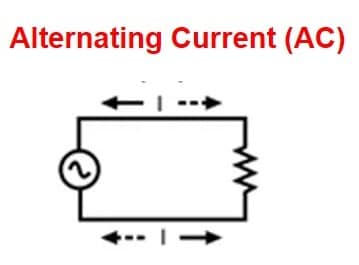
Houses, office buildings, and other structures are powered by AC power. Electric motors, such as dishwashers and refrigerators, can also be powered by AC power.
Alternating Current Properties
- An alternating current reverses the direction of charge flow (60 times per second in North America, 50 times per second in Europe).
- It is produced by a sinusoidal fluctuating current and voltage that reverse directions, causing a periodic back-and-forth motion for the current.
- Despite the fact that the current is moving back and forth numerous times per second, the energy from the power plant to the electronic gadgets is basically continuous.
- One of the biggest advantages of alternating current is that its voltage can be easily changed with a transformer, allowing power to be carried at extremely high voltages before being reduced to safer voltages for commercial and domestic use.
How we get AC at Our Homes
- Generating and transporting AC across long distances is relatively easy.
- First, electricity is generated by massive generators that use wind, coal, natural gas, or water to generate electricity.
- The AC is then sent via transformers, which boosts the voltage and allows the power to travel great distances.
- High-voltage transmission cables carry the electrical charge. The voltage is then decreased at a substation so that it may be sent across smaller power lines.
- The charge goes through distribution lines to a neighbourhood, where smaller transformers lower the voltage so that it is safe to use in houses.
- The power is then connected to the house, where it travels via a meter that measures the amount of electricity used by the household.
- Breakers/fuses safeguard the wires from becoming overloaded while the electricity passes through a service panel.
- The electricity is then sent through wires to the home’s outlets and switches.
Direct Current
Direct current (DC) is a unidirectional electric current in which the charge flow is always in the same direction. Direct currents, unlike alternating currents, do not fluctuate in direction or amperage. It’s found in a variety of household electronics as well as all battery-powered devices.
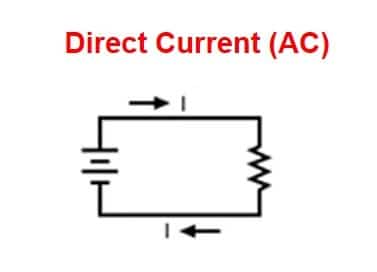
Direct Current Properties
- The steady flow of electrons from a high electron density area to a low electron density area defines direct current.
- Direct current is far more expensive and harder to vary the voltage as compared to alternating current, making it an unsuitable choice for high-voltage transmission.
- Any electrical gadget using a battery as a power source uses direct current.
- It’s used to charge batteries, which is why rechargeable gadgets like laptops and mobile phones have an AC adapter built-in that converts alternating current to direct current.
Voltage definition
The voltage between two ends of a path is the total energy required to move a small electric charge along that path, divided by the magnitude of the charge.
A voltmeter can be used to measure voltage. The volt is the measuring unit.
The voltage between two points in a static electric field is equal to the electrical potential difference between them.
Electric Field
A field or space around an electrically charged particle where another test charge experiences a force of attraction or repulsion is known as an electric field (E.F). Furthermore, an E.F. can be described as an electric property connected with a specific point in space when some sort of charge is present.
The letter “E” is used to signify it.
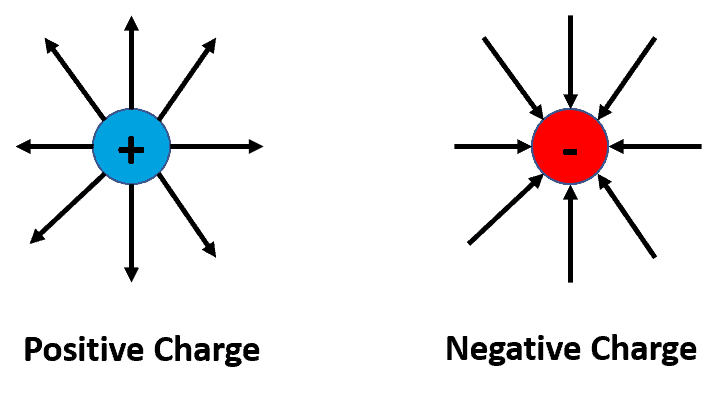
Electric Field Strength
The electric field strength at a point is the Coulomb force (F) exerted per unit positive electric charge (q) at that point. Its equation is given as follows:
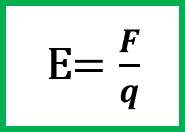
Where F = force acting in newtons and q = charge in coulombs.
Examples of electricity
- The electricity is sent from the generator to the national transmission network, commonly known as the “national grid” or simply “the grid,” and then to all of the homes and businesses that utilize electricity.
- Wind turbines work in a similar fashion to conventional generators, but they use wind energy to spin the turbine and generator.
- Thermal generators produce heat by burning fossil fuels. Some thermal generators run the turbine and generator directly with hot combustion gases, while others boil water to create high-pressure steam that rotates the turbine and generator.
- Geothermal generators make use of hot steam created naturally beneath the ground in several sections of the country, primarily in the Bay of Plenty.
Summary
- Electric current is the rate of flow of negative charges in a conductor.
- Ampere is the unit of current.
- Current is one ampere if 1 columb charge flows in one sec.
- There are two types of electric current: alternating current (AC) and direct current (DC)
- AC produces sinusoidal fluctuating current and voltage that reverses directions.
- A DC is a unidirectional electric current in which the charge flows in one direction only.
More Links
Power Units- The Basics
Surface Charge density
Static Electricity| Simple Explanation
Electric Field Units & Definition
Is Aluminum Conductive?| Simple Explanation
Eddy Current- Definition- Easy Words
Frequently Asked Questions
Some of the frequently asked questions are given below:
1. What is the current definition?
A flow of electrical charge carriers, usually electrons or electron-deficient atoms, is referred to as current. The uppercase letter I is a typical sign for current. The ampere, abbreviated as A, is the standard unit.
2. What is the electric current formula?
According to Ohm’s law, the current flowing through a conductor is proportional to the voltage V and resistance R (V = IR). The electric current formula can be expressed as I = V/R.
The letter I is commonly used to represent the current.
3. What is resistance definition?
In an electrical circuit, resistance is a measure of the resistance to current flow. The Greek letter omega (Ω) is used to represent resistance in ohms.
4. What is electricity?
When electrons flow through a conducting substance, such as copper or aluminum used in power lines, electricity is produced.
5. What is current electrical?
Current electrical (electrical current) refers to the continuous movement of electrons in a conducting substance. The conducting substance (usually metal) is made up of a vast number of free electrons that travel randomly from one atom to the next.
More Interesting Topics
- BCl3 Lewis Structure in four simple steps - November 1, 2023
- PH3 Lewis Structure in four simple steps - October 8, 2023
- PF3 Lewis structure in four simple steps - September 24, 2023

